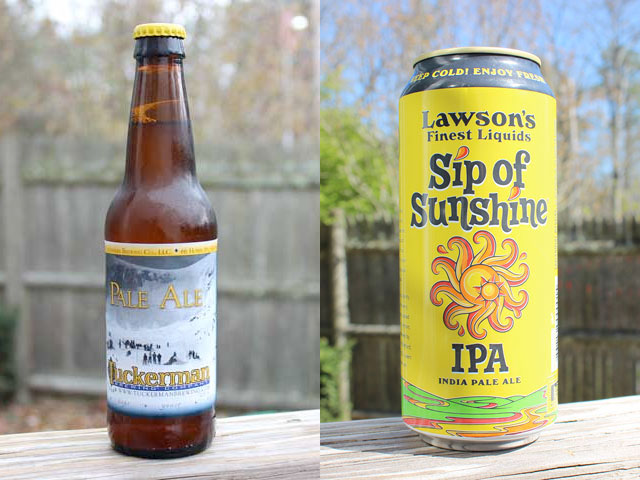Pale Ale VS IPA - Exploring Flavor Profiles of Both Beer Styles
Whether you’re a seasoned beer connoisseur or somebody who’s just getting to know the beauty and complexities of beer, chances are you’ve heard of both Pale Ales and IPAs (India Pale Ale).
Written by CraftJack | Updated | 3 min read
Interesting Tools
- Beer BrüMate Hopsulator
- Brewing Northern Brewer Beer Making Kit
- Spirit Crystal Whiskey Glasses
- Wine Wine Decanter/Aerator

They are some of the most popular and beloved beer styles you can find in any brewery.
Over time, as brewers became more innovative, more and more varieties of both pale ale and IPA became available all over the world. Still, these two styles are at the foundation of modern beermaking, and knowing how to distinguish them is a must for all beer lovers. So let’s take a look at the short history of these two beers, as well as their flavor profiles, and everything else you need to know.
Are Pale Ales and IPAs the same thing?
Historically, India Pale Ale does come from the pale ale, which first appeared in the early seventeenth century. The original version of IPA was made much later, in the first half of the eighteenth century, due to the big demand for English beer in India.
The pale ale of the time couldn’t survive the long journey on British boats, and the solution was to use more hops in it, to preserve it for longer. This made IPA much stronger and more bitter than a pale ale, so much so that it became a separate beer style.
So technically, pale ales and IPAs do come from a common ancestor but over the centuries, they’ve each developed their own flavor profiles and subtypes. A good thing too, because beer a few centuries ago was nowhere near as delicious as the one we have today.
Pale Ale vs. IPA – Differences and Flavor Profiles
Since these two beer styles are among the all-time favorite beers for beginners, it’s a good idea to learn more about how they look and taste. Once you get the hang of the basics, you can get into the nitty-gritty of it and figure out how to differentiate sub-styles as well. Here are some things you should pay attention to.
Different ABV (Alcohol by Volume)
This is one of the biggest differences between pale ales and IPAs. We mentioned that IPA came to be when beermakers were trying to prevent the beer from going stale during its long trip to India. Their solution – put more hops into it!
This worked like a charm, and the end result was a concoction much stronger than your regular pale beer. To this day, the fermentation process of these two varieties remains similar, but the ABV is what sets them apart. India Pale Beer has a higher ABV (up to 7.5%), with double IPAs being even stronger (as much as 10% ABV).
Pale ale is, by comparison, milder, and usually stays in the 5% ABV ballpark. However, there are some that can get up to 6% if you’d like to experiment with stronger options. The general rule of thumb is that IPAs take the lead when it comes to higher alcohol content – this is your starting point when learning how to set them apart.
The Hoppiness
Sounds very similar to happiness, doesn’t it? When we say that a beer is “hoppy,” it means that you can clearly smell and taste hops in it.
Different types of hops are used for different beer styles. In pale ales, you can expect citrusy and light aromas mixed with Cascade, Amarillo, and Chinook hops, among many others. On the other side, Citra, Columbus, Mosaic, and Galaxy hops are dominant in IPAs. Remember that the same types of hops can be used both in pale ales and IPAs, but there will be more of it in the latter.
This means that pale ales are generally on the lighter side when it comes to hoppiness, and their malt flavor isn’t as pronounced. You’ll recognize a pale beer by its deep golden color and it’s usually served in standard nonic pints. Pale ales aren’t supposed to be cold, so keep them out of the fridge, as cold could affect their taste.
Not to much surprise, IPAs are the ones that have a stronger hoppy taste, since they’ve got a higher content of hops. These beers have an expressive malt flavor, they’re warmer, earthier, and hop-forward. With more hops comes more of its signature bitterness, so IPAs might be an acquired taste for some. You’ll get the most out of its complex flavor profile when you serve it in a goblet-shaped glass. Unlike its pale ale cousins, you’ll want to slightly chill your IPA before you drink it at a temperature of up to 50°F.
Different Types of Pale Ale and IPA
Beer brewing has reached new heights in previous decades, and it seems that the trend will only continue. That’s why you’ll find a wide variety of both pale ales and IPAs that you can choose from.
Some of the most popular pale ale styles include English Bitters, American Pale Ales, and Light Pale Ales. In Europe, you could come across Irish Red Ale, Bière de Garde, and many more.
On the IPA side of things, you could encounter anything from White, Hazy, and American IPA to Double and Black IPA. Each offers a unique drinking experience, so it’s a good idea to taste them all to determine which one suits you best.
